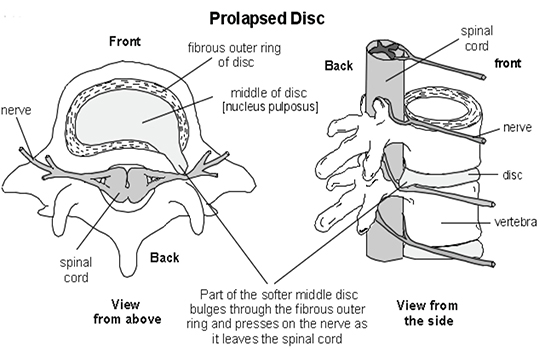Prolapsed Disc/ Slip Disc/ Disc Bulging
A prolapsed disc (Generally known as a Slip Disc), often causes severe lower back pain which radiates to other parts of the body too. Before we jump on the causes, it is important to understand about our spinal structure. As depicted in the picture above, the spine is made up of many bones called vertebrae which are roughly circular and between each vertebra is a disc. These discs are made of strong rubber-like tissue which allows the spine to be fairly flexible & has a stronger fibrous outer part, and a softer jelly-like middle part called the “Nucleus Pulposus”.
The spinal cord, which contains the nerves that come from the brain, is protected by the spine. Nerves from the spinal cord come out from between the vertebrae to relay messages to and from various parts of the body. The strong ligaments attach to the vertebrae, gives extra support and strength to the spine along with the various muscles that surround, and are attached to, various parts of the spine.

When you have a prolapsed disc (commonly called a slipped disc), a disc does not actually slip. What happens is that part of the inner softer part of the disc (The Nucleus Pulposus) bulges out (Herniates) through a weakness in the outer part of the disc & this bulging disc may press on nearby structures such as a nerve coming from the spinal cord. Due to the pressure of the bulging disc on a nerve root, it can cause severe pain and other symptoms in a leg.
Some inflammation also develops around the prolapsed part of the disc making it even worse to bear. The usual advice is to do normal activities as much as possible. Depending on the case, generally doctors prescribe some steroids, surgery or put you on long medications, BUT this can be treated without any medicines, without expensive tests like M.R.I. and yes WITHOUT SURGERY.
What causes a prolapsed disc?
Risks of developing a prolapsed disc.

This is strange but a fact that it is not clear why some people develop a prolapsed disc and not others, even when they do the same job or lift the same sort of objects.
There could be many reasons to this and it seems that some people may have a weakness in the outer part of the affected disc and hence various things may trigger the inner softer part of the disc to bulge/ prolapse out through the weakened outer part of the disc. For example, even sneezing, awkward or wrong posture bending, heavy lifting in an awkward/ inappropriate position may cause some extra pressure on the disc and to prolapse.
Factors that may increase the risk of developing a prolapsed disc include: a job involving lots of lifting, a job involving lots of sitting (especially driving), weight-bearing sports (weight lifting, etc), smoking, obesity, and increasing age (a disc is more likely to develop a weakness with increasing age).
Prolapsed disc symptoms
Symptoms
The term sciatica means nerve root pain of the sciatic nerve. The sciatic nerve is a large nerve that is made up from several smaller nerves that come out from the spinal cord in the lower back which travels deep inside the buttock and down the back of the leg. There is a sciatic nerve for each leg.
Nerve root pain is pain that occurs because a nerve coming from the spinal cord is pressed on (trapped) by a prolapsed disc, or is irritated by the inflammation caused by the prolapsed disc. Due to the pressure built on the nerve root, the blood flow stops/ slows down and hence even though the problem is in the back, you feel pain along the course of the nerve in addition to back pain. Therefore, you may feel pain down a leg to the calf or foot.
Nerve root pain can range from mild to severe, but it is often worse than the back pain. With a prolapsed disc, the sciatic nerve is the most commonly affected nerve.
The pain is often severe, and usually comes on suddenly. The pain is usually eased by lying down flat, and often gets worse if you move your back, cough, or sneeze. Though the researches have shown that some people have a prolapsed disc without any symptoms.
It is thought that symptoms mainly occur if the prolapse causes pressure on or irritation of a nerve. This does not happen in all cases.
The irritation or pressure on the nerve next to the spine may also cause pins and needles, numbness or weakness in part of a buttock, leg or foot. The exact site and type of symptoms depend on which nerve is affected.
In some cases it is seen that the legs of the patients becomes too weak to cary the body weight and patient falls frequently or have to use the walkers, stick/ walking canes etc.
